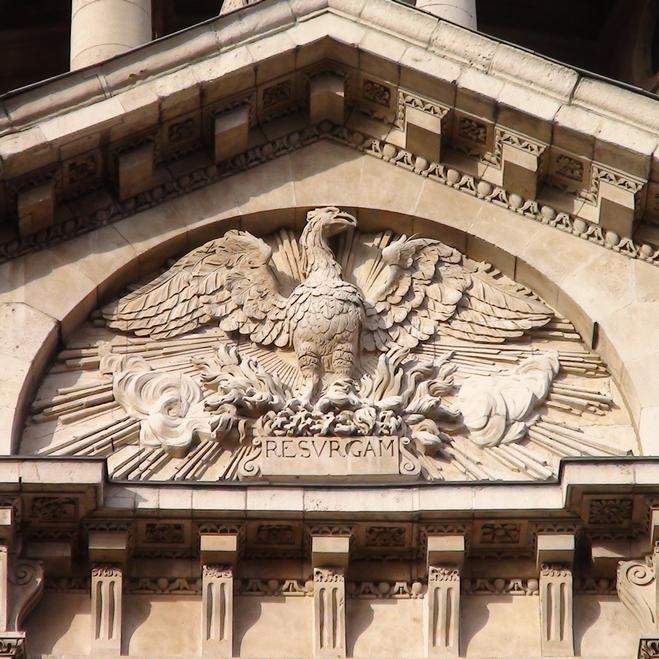On the 11th June 1144 Abbot Suger of the Abbey of St Denis, Paris, gathered the bishops of France for the dedication of his newly built choir and east end. This marked a sea-change in architecture, gone was the heavy solidarity of the Romanesque and in came the lightness and delicacy of the Gothic. In the years after the meeting of the bishops, many of their home cathedrals would burn down only to rise from the ashes in the new gothic style of Suger’s St Denis.
We have fire to thank for many of Europe’s most beautiful cathedrals. The clean slate it afforded often allowed for great expressions of newer styles of architecture and methods of construction that were only pipe dreams before a blaze. So, whilst the rolling news coverage of the 2019 Notre Dame fire, or the recent arson attack on the cathedral of Nantes, are shocking and saddening, they are not unusual in the lives of cathedrals – and not necessarily bad news.

Historically fires in the cathedrals were very common. The cathedral at Bayeux, Normandy, for which the eponymous tapestry may have been designed, burned down no fewer than three times between 1077 and 1160. Whilst Angers cathedral, on the banks of the Loire, was reduced to embers in 1032, immediately after its completion. Buildings of such a scale are hard to keep from combustion even in this age of sprinklers and firefighters, in the middle ages the task was nearly impossible – a cathedral fire was an occupational hazard for any bishop.
We, today, do not mourn the 1218 fire at Amiens or the destruction of the east end at Canterbury in 1174, why? Because without these catastrophes we would not have the glorious, gothic, wedding cake of a cathedral in Picardie or the stained-glass encrusted pilgrimage site of Becket in Kent. These catastrophes, although terrible in their destruction and tragic in their scale, have in turn prepared the ground for even more wonderful works of art to rise from the ashes.
All these examples, although archaic, have something in common. An ambition to innovate in their rebuilding. Once razed by fire they would be raised in a new style, a bigger, better, brighter style that would speak to the posterity of their generation’s skills, talents, and devotion.

This drive to rebuild anew is nowhere better exemplified than in Sir Christopher Wren’s daring design for St Paul’s Cathedral, London. In 1666 there was nothing left of the original gothic building after the flames of the Great Fire abated, the only sign of it today is the footprint on which the new cathedral sits. Instead Wren’s shining, be-domed, baroque creation has achieved international celebrity. Its ambitious engineering and innovative silhouette have become synonymous with a golden age in British history.
I am not, of course, advocating for an entirely new Notre Dame to be built – there is far too much left of the original for that. (Neither, for that matter, am I suggesting we all go about setting light to our local cathedrals – as some cretin in Nantes has done this week.) But the Notre Dame fire did offer an opportunity for our epoch to leave its mark on the site – the replacement of the spire.
We all saw the footage of the nineteenth-century wooden spire collapse amongst the licking flames of the inferno and the various proposals from architects around the world for its reconstruction. This was a perfect opportunity to rebuild a part of this great building on our own, twenty first-century terms and crucially without infringing on the great medieval fabric. However, it has now been quashed by the Macron government – in a desire to have the reconstruction completed for the 2024 Paris Olympics, the decision has been made to build an exact replica of the nineteenth-century spire.

Whilst this is far from a disaster, as the old spire has some merit of its own, it does feel to me like a wasted opportunity. When my local cathedral, LLandaff, was hit by a bomb in 1941 it was reconstructed much as before but with the notable addition of George Pace and Jacob Epstein’s concrete chancel arch and majestas sculpture. To the north side Pace also added a modernist chapel dedicated to the Welsh Guards, different from the gothic of the main cathedral but working in symbiosis with it. In the nineteenth century the collapsed medieval south tower was replaced by a grand, Victorian, gothic revival spire, the skyline of which is now synonymous with LLandaff and indeed Cardiff as a whole. Whether one appreciates these interventions, it has the quality of ensuring the continued use of the site is reflected in its fabric – every century has left its mark in some way at LLandaff.
Watching clips of this week’s fire at Nantes cathedral I am thankful it has not become another Notre Dame (although the complete destruction of a unique pre-revolutionary organ is deeply regrettable). The flames leaping through the west window put me in mind of a tale about St Paul’s, London. When Wren walked through the charred remains of old St Paul’s he turned over a fragment of masonry. On it he found a word carved, ‘RESURGAM’, “I shall rise again.” He decided at that moment to build his great dome exactly on that spot.

Although probably apocryphal it does speak to the ambition of the rebuilders of the past, their reverence for the old but equally their commitment to the new. If one walks to the south transept of St Paul’s today, above the door is carved a phoenix bursting from the flames, and beneath is written ‘RESURGAM’.
No doubt Notre Dame will rise again and be just as beautiful as before, if not more so with the knowledge of the tragedy it survived. But I will never be able to look at it again without thinking of what could have been, of the opportunity missed for a lasting statement of our troubled epoch.
